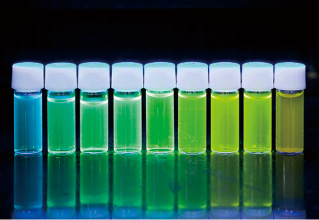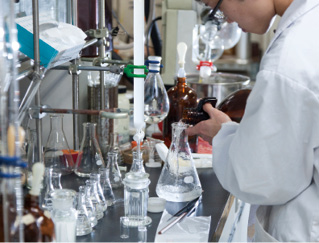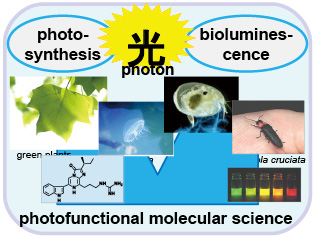OPAL-RING
Takashi HIRANO Laboratory
Pioneering the science of photofunctional molecules based on biological functions associated with light
| Faculty/Department | Department of Engineering Science Graduate School of Informatics and Engineering |
|---|---|
| Members | Takashi Hirano, Professor |
| Affiliations | Chemical Society of Japan; Japanese Photochemistry Association; Society of Synthetic Organic Chemistry, Japan; American Chemical Society, American Society for Photobiology |
| Website | http://www.firefly.pc.uec.ac.jp/ |
As of August, 2015

- Takashi HIRANO
- Keyword
-
Bioluminescence; chemiluminescence; fluorescence; supramolecules; bioimaging; biosensor; luciferase; luciferin; luminescent materials; photochemical reaction; organic synthesis, molecular electronics
Summary of Research
Studies on Bioluminescence, Photosynthesis, and Other Remarkable Biological Functions Associated with Light
In recent years, the luminescent substances that cause organisms such as fireflies and sea fireflies (Vargula hilgendorfii) to emit light have been studied and applied to create labeling agents in the fields of medicine and biotechnology. While these results have prompted further research to clarify the mechanisms underlying bioluminescence, many principles and reaction mechanisms remain to be resolved.
Our laboratory specializes in photochemistry and is active in various studies based on chemistry with the goal of pioneering the science of photofunctional molecules modeled on biological functions associated with light.
We begin by establishing the basic chemistry of luminescent substances of biological origin through studies of bioluminescence in organisms such as fireflies, sea fireflies (Vargula), and jellyfish (Aequorea). We then develop applications based on the results, including labeling agents that can be used in bio-imaging technologies to visualize biological activity and to develop light-emitting molecules for molecular electronic applications.
We have also embarked on research to pioneer the development of a green photochemical reaction modeled on photosynthesis that incorporates concepts from both supramolecular chemistry and catalyst chemistry.
The research in photochemical science at our laboratory is characterized by a dual focus on two reactions: the light-emitting reactions (bioluminescence) of organisms and the reactions that take place when organisms are exposed to light (photosynthesis).
Elucidating the Excited State of the Luminescent Compound in Fireflies; Understanding the Mechanism of Luminescence at the Molecular Level
We have achieved impressive results in bioluminescence studies in our years of research at the photochemical laboratory of the University of Electro-Communications, particularly on high-efficiency luminance, emission color modulation, reaction regulation, and the design of supramolecules. We have performed detailed studies of the mechanisms of luminescent chemical reactions, including methods for inducing highly-efficient emissions in the substances used by fireflies, sea fireflies, jellyfish, and other luminous organisms; methods for modulating the color emitted; and methods for accelerating the reactions involved. These are all basic but leading-edge research involving the processes of elucidating the chemical structure and reactivity of the luminescent substance based on electronic states and molecular properties, as well as elucidating bioluminescent phenomenon at the molecular level based on an identification of the molecular frame suitable for bioluminescence, the mechanisms required to produce the excited state and the process of light emission from excited molecules, with the ultimate goal of creating new molecules based on the knowledge gained and theories established through the former two processes.
A substance (molecule) generally exists in the ground state (a stable state). When irradiated with light (that is, when energy is applied), it is first promoted to an excited state (state of higher energy), then eventually returned to the ground state by emitting light. In the case of bioluminescence in fireflies, light is emitted when the fireflies generate a luminescent product (oxyluciferin) in the excited state through the energy of the chemical reaction involving the luminescent substance (luciferin) and oxygen, a process regulated by the luminescent enzyme (luciferase). This highly efficient reaction is known to progress in multiple steps. Our persistent efforts have sought to uncover the mechanism for each step in the reaction, focusing on the role played by each in realizing such efficient luminescence.
Advantages
Uncovering Many New Facts on Bioluminescence and Elucidating Their Principles

- Multi-colored fluorescent pigment based on luminescent compounds found in fireflies
We have succeeded in discovering many new facts through an approach that focuses on establishing theories for molecular design based on the principles of bioluminescence. The theories and knowledge established regarding bioluminescence mechanisms have allowed us to pursue research projects that contribute to the development of various photofunctional materials exploiting the properties of bioluminescence, including luminous and fluorescent pigments. This understanding has also enabled molecular modification studies capable of forming the backbone of research and development for novel substances.
As the leading experts on the principles associated with sea firefly bioluminescence, we have established our understanding to develop applications of this reaction. To date, we have used luciferin (a luminescent substance), involved in the bioluminescence of the sea firefly, to produce a commercial reagent that detects reactive oxygen species (ROS). However, this reagent takes advantage of the light-emitting property of a simple derivative of luciferin when exposed to ROS.
To develop new photofunctional materials of greater sophistication, we are gathering knowledge on the reaction mechanisms of luminescent substances, including features of molecular structures that make bioluminescence possible, the decomposition of the chemically active species that allow efficient bioluminescence, the functions of luciferase (luminescent enzyme), and the properties of the excited state of molecules that result in efficient light generation.
Clearly, an understanding of the properties of the excited state of the molecules involved in luminescence is critical to the study of luminescent substances. One advantage offered by our laboratory is that we pursue research and development for luminescent substances that draw on both experiments that investigate the excited state of molecules and computational chemistry techniques.
Controlling the Color and Intensity of Luminescence to Explore Multi-Colored Luminescence

- Organic synthesis of photofunctional materials
To date, supported by experiments, we have succeeded in uncovering new facts concerning the reaction mechanisms underlying bioluminescence. We have also produced substances, marketed as labeling reagents, that exploit these mechanisms to function as sensors that change color when specific metals or solvents are present. Such reagents are applications of the curious properties observed in natural substances.
An organism related to fireflies and found in Brazil called the railroad worm such as Phrixothrix hirtus - the head emits red light and the body emits green or yellow light. The same luminescent substance has been implicated in the emission of both colors; the two colors are produced by minor differences in the luminescent enzymes.
Through repeated experiments under varied conditions involving oxyluciferin, the luminescent product and the substance responsible for this bioluminescence, our laboratory became the world’s first to verify that a single luminescent substance can be made to emit light from green to red and that the intensity and color of this light can be regulated.
Future Prospects
Joint Projects to Support the Development of Advanced Technologies in Photofunctional Molecular Chemistry
Our main focus looking forward will be the strategic exploitation of the reaction mechanisms underlying bioluminescence and the process of promoting the excited state to develop applications in other fields. We plan to establish a theoretical framework and principles for these mechanisms and processes to make it possible to develop applications that will serve as the foundations for basic research in cutting edge technologies. Going beyond labeling reagents, we have initiated basic research on establishing and applying basic photochemical technologies to develop advanced nanotechnologies, bioimaging technologies to visualize biological activities and environmental science technologies. We are also pursuing basic research to develop light-emitting molecular devices for molecular electronics applications.
In these research areas, we plan to create luminescent substances exhibiting various characteristics, such as fluorescent pigments and luminous zeolite materials for organic light-emitting diodes (OLEDs) and to pioneer the field of photofunctional molecule science modeled on bioluminescence.
Our knowledge and research results offer the potential for application to a wide range of materials that may benefit from light-emitting properties. We believe we can serve as productive partners for companies interested in joint research to develop photofunctional reagents and materials, responding to the demand to identify the appropriate luminescent substance for a specific application or to create luminous/fluorescent/color reagents to detect specific substances.
Designing New Methodology for Artificial Photosynthesis as a Contribution to Human Society

- Photofunctional molecular science based on photosynthesis and bioluminescence for human welfare
In the area of light-receiving reactions (photoreactions), the other pillar of research at our laboratory, we plan to perform pioneering research on reactions that simulate photosynthesis in plants. As we all know, light energy is converted into chemical energy in the process of photosynthesis by the synthesis of carbohydrate molecules from carbon dioxide in the presence of light, a process that removes carbon dioxide from the atmosphere.
The fascination with the process of photosynthesis is what originally attracted me (Professor Hirano) to the world of organic photochemistry. As one might expect, we approaches the study of artificial photosynthesis with high ambitions. The research currently underway integrates modern concepts and conventional methods in photochemistry to identify new research seeds. By combining the techniques of organic photochemistry, our main specialty, with the techniques of supramolecular chemistry and catalyst chemistry, we aspires to contribute to research in and the development of green photoreaction technologies that will advance environmental engineering and science. Our laboratory hopes to continue developing technologies and applications that benefit human welfare.
